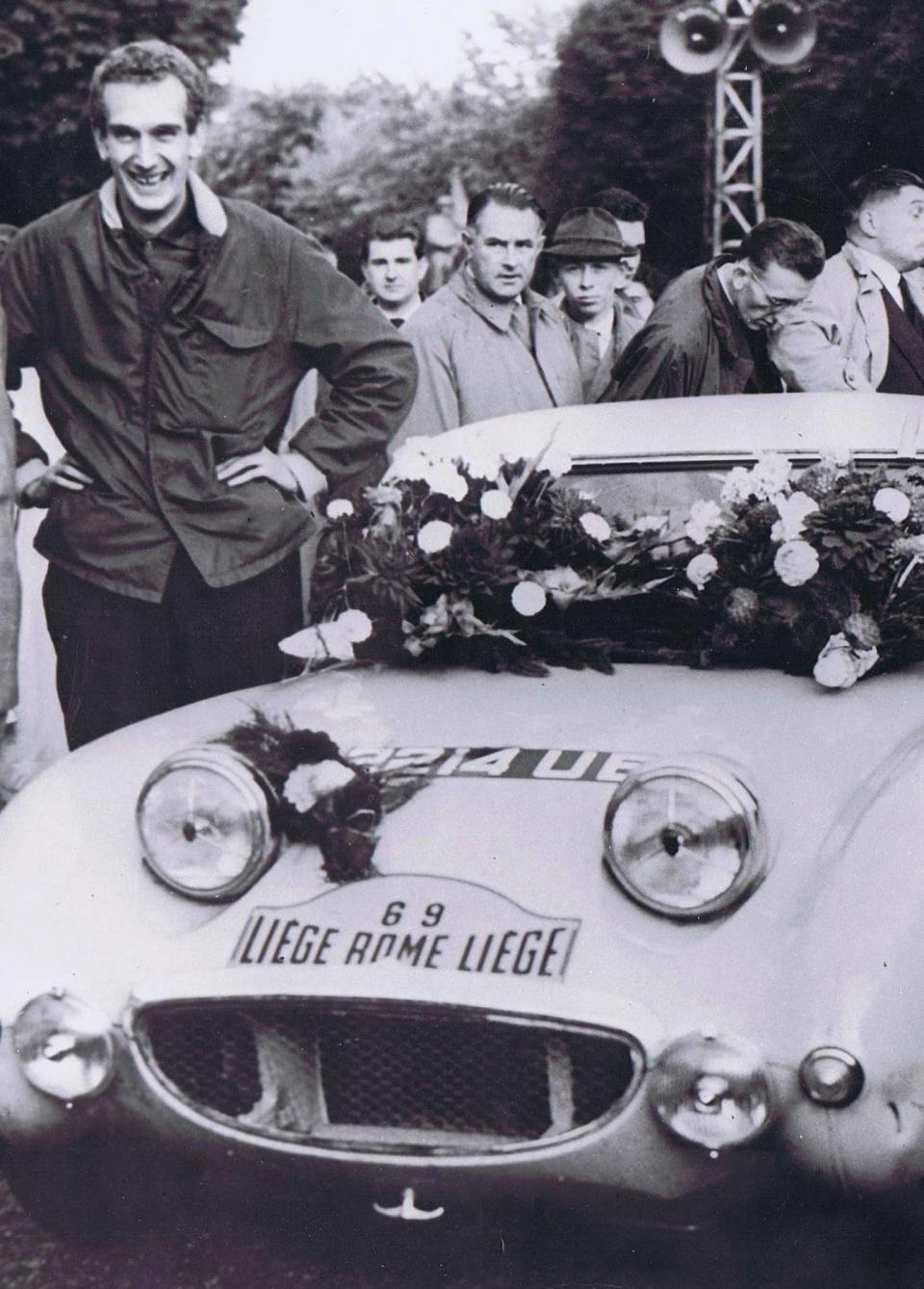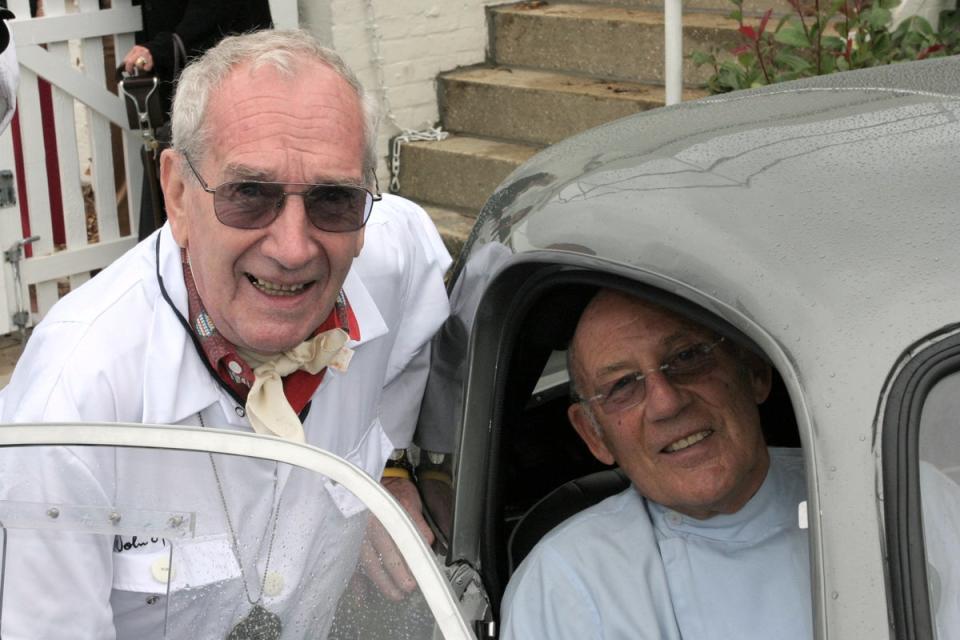John Sprinzel: Rally champion and motorsports entrepreneur

John Sprinzel, who has died aged 90, was a British international saloon car, touring car and rally racer who won the British Rally Championship (BRC) in 1959 and went on to become a successful racing car modifier, motorsports entrepreneur, author, rally organiser and world championship-level windsurfer. Having set up a school teaching the fledgling sport of windsurfing in Corfu, he was part of the Greek team in the world championships of 1982 and ’83.
For most of his life, he was dedicated to making road cars go faster, from Austin A-35s and Morris Minors to Austin-Healey Sprites, culminating with the highly successful Sebring Sprite which he largely developed. One of the first mechanics he hired for his own Speedwell racing team in Golders Green, London, was a 28-year-old called Graham Hill, who would go on to become double Formula One World Champion for BRM and Lotus and win both the Indy 500 and the 24 Hours of Le Mans.
Sprinzel himself drove a Sprite and an Alfa Romeo Giulietta TI to win the 1959 BRC and another Sprite to finish 14th of the 186 finishers in the Monte Carlo rally the same year. In 1960, he came second in both the RAC rally in Britain and the Liege-Rome-Liege event, as well as fourth in the Safari Rally in a private-entry Mercedes 190.
As a road racer, this time in an American 7-litre Ford Galaxie – “the first Galaxie to arrive in England,” he said – he started in pole position for the 1963 Brands Hatch Six Hours endurance race but, in horrendously wet conditions, was being well beaten by the Jaguar Mk II 3.8 entrants when his bonnet came loose and he was disqualified.
Sprinzel also drove in the 1960 12 Hours of Sebring sports car endurance race in Florida in an Austin-Healey Sprite he had modified and called the Sebring Sprite. That model became something of a legend in the sport, dicing with the mighty Ferraris and Porsches on the track despite its much smaller engine.
When Australian advertising mogul Wylton Dickson and Northern Irish rally driver Paddy Hopkirk had what they rightly called the “madcap idea” of a London-Mexico rally in 1970 to coincide with England’s participation in the World Cup football finals there, they turned to Sprinzel to organise it.

He rounded up 96 entrants from 22 countries to start from Wembley Stadium, scene of England’s World Cup triumph four years earlier, on a 38-day, 16,000-mile odyssey through 19 countries via a boat crossing from Lisbon to Rio de Janeiro, and ending up at Mexico City’s Azteca stadium where the 1970 final would be played. On 19 April, winning World Cup manager Alf Ramsey waved the starter’s flag. His on-field captain Bobby Moore was there to dig up a sod of the hallowed turf to be carried in the boot of each entrant and re-planted at the Azteca. Word has it that most sods were found just outside Calais as drivers relieved themselves of car weight as well as bodily fluids.
Working from a basement office in Belgrave Square, London, Sprinzel persuaded Moore’s 1966 World Cup squad teammate Jimmy Greaves, a self-confessed “petrolhead,” to drive a Ford Escort alongside professional rally ace Tony Fall. Nor did the 27-year-old Prince Michael of Kent, a cousin of the Queen and inveterate “boy-racer” need much persuading to take part in an Austin 1800. Greaves finished an astonishing sixth in the rally while Prince Michael was last seen somewhere in Mexico although he eventually resurfaced safely in Mexico City.
The rally was won on 27 May by Finnish driver Hannu Mikkola and his Swedish navigator Gunnar Palm in a works Ford Escort sponsored by The Daily Telegraph. That was a story in itself: the rally was sponsored by the Daily Mirror, which spent a fortune on it in the hope of boosting its readership during the World Cup years. But the Telegraph had quietly cut a deal with the two drivers and the Ford motor company, knowing they had a strong chance of winning in their well-prepared Escort 1850 GT. To the Mirror’s annoyance, the outcome was a scoop for the Telegraph, which had exclusive rights to Mikkola and Palm’s stories.
To this day, given the challenging logistics of half a century ago, it is considered one of the greatest endurance rallies ever held, and one of the best-organised.
Hans Helmut Sprinzel was born in Berlin on 25 October, 1930, but when Hitler came to power in 1933, initiating repression against Jews and the vandalising of Jewish businesses, his father Paul, a silk screen printer in the fashion industry, knew far worse would soon come. He moved the family to England and set up his own printing firm in Golders Green, London. Young Hans became known as John and was granted British nationality in 1940.

He was educated at Christ’s College secondary school in Finchley, north London, and the Regent Street Polytechnic in the centre of the capital before starting as an apprentice printer in his father’s firm after the Second World War and doing his compulsory two-year national service in the royal air force (RAF). He then worked for another printing firm as production manager before he got the bug for motorsport and felt the need for speed.
In 1949, aged 18, he began “grass tracking races” on his Ariel Red Hunter motorcycle. In 1955, moving to four wheels, he entered the RAC Rally, saying he would be driving an Austin A30. So early did he enter that he was given the No 1 to stick on his bonnet and doors. The only snag was that he didn’t have an A30. So he called his mother and asked if he could borrow hers to go for a quiet sightseeing trip to Wales with a mate.
She was fine with that until BBC TV showed a clip of the RAC Rally finishing in Blackpool, with an Austin A30 finishing fifth in its class. “Later, I heard that Mum had said to Dad, ‘That looks like John! That looks like my car!’ … Mum was a good sport,” Sprinzel recalled. Having souped up an Austin A35 himself, he won his first road race at Goodwood on Whit Monday, 1957. Motorsports buffs were beginning to take note of the name Sprinzel.
“We agreed that we had to take advantage of this, as these people wanted conversions to their cars,” he recalled. “So we opened up a business [Speedwell], working part time, and it got so successful, so quickly. Then, a young man named Graham Hill walked in the door during my printing morning shift and said, ‘I hear you need some mechanics!’ In the end I sold out [the business] to Graham.”
Sprinzel then set up John Sprinzel Racing in London’s Lancaster Mews, which attracted not only petrolheads but celebrity buyers or simply wanna-be-seeners. At the time, he was the biggest MG dealer in the world. He recalled Brian Jones of the Rolling Stones coming in with friends in a Cadillac. “He was a bit out of it,” Sprinzel recalled.
Sprinzel had his last motorsports drive in an MG Midget in the 1968 London-Sydney rally. He was in the top 10 overall, and the leading private entrant, when the Midget suffered a broken stub axle. His at-the-wheel career was over.
After his rally organising and subsequent retirement, Sprinzel sought out a life first on the land, and thereafter by the ocean, one of his first loves as a child. Leaving a small farm in Northamptonshire, he sailed his yacht for a while with his wife Caryl, mostly around the Aegean, before setting up a windsurfing school in Corfu. That led to him help organise a Greek team, who asked him to participate with them in the fledgling world championships of 1982 and ’83.
He and Caryl later “retired” – although both were still active in sport and local community work – to the small Hawaiian island of Molokai, a former leper colony. For many years, he was chairman of the island’s planning council and he completed three volumes of memoirs: Sleepless Knights (1962), Spritely Years (1994) and Lucky John (2013), the latter title referring to the various career shunts that led to his nickname. He also wrote regular motorsports columns for the specialist magazines and British national newspapers including The Times and The Daily Telegraph.
His wife Caryl said he died on Molokai during the last few days of May but she did not wish to specify the date or cause of his death. He had kept windsurfing into his eighties – “probably the oldest windsurfer in the world,” he said recently, adding that his wife was “a better windsurfer and driver than me”.
John Sprinzel, motorsports driver and entrepreneur, born 25 October 1930, died May 2021
Read More
UK weather: The latest Met Office forecast
Jack Taylor: Referee best known for awarding the first penalty in a World Cup final

 Yahoo News
Yahoo News 